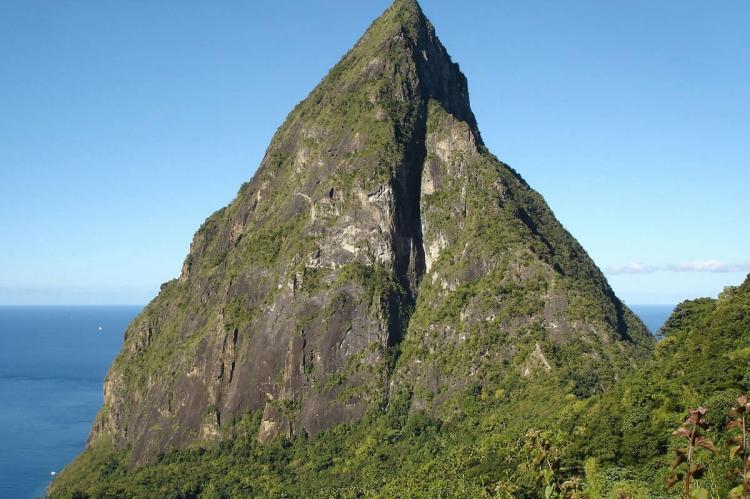Volcanic Sentinels of Saint Lucia: The Pitons and Soufrière Complex
Located in the Eastern Caribbean, Saint Lucia boasts breathtaking geological wonders. The Pitons, two towering volcanic spires that emerge from the sea, is the country's most iconic landmark. They are recognized as an important geological site alongside the Soufrière Volcanic Center.
Volcanic Sentinels of Saint Lucia: The Pitons and Soufrière Complex
Beyond the idyllic beaches and lush landscapes that draw visitors to Saint Lucia, this Eastern Caribbean gem harbors geological wonders that ignite the imagination. The Pitons, two volcanic spires thrust skyward from the surrounding Caribbean Sea, stand as the island's most iconic landmark. Gros Piton and Petit Piton, along with the surrounding Soufrière Volcanic Center, form a landscape that is not only breathtakingly beautiful but also holds immense geological significance.
Silent Sentinels
The Pitons, Gros Piton and Petit Piton stand as silent sentinels, their formation a testament to Saint Lucia's fiery past. These volcanic plugs, not lava domes, were born roughly 200,000 to 300,000 years ago. Unlike surrounding volcanic features, they weren't ejected but crystallized within the volcano's vents, marking a critical stage in the island's volcanic evolution. Pre-dating the caldera's formation, they serve as a window into this earlier period.
Deep within the Earth, immense heat and pressure birthed the Pitons. Molten rock, forced upwards, solidified within the volcanic vents. Over millennia, countless eruptions built upon this solidified core, shaping the Pitons' recognizable silhouettes. Today, their steep slopes and jagged peaks, remnants of a violent past, stand in stark contrast to the lush vegetation that now clings to their slopes.
The Soufrière Volcanic Center
Jalousie Bay flanks Gros and Petit Piton, while the vast Qualibou Depression, encompassing the Soufrière Volcanic Center, forms a dramatic backdrop. This caldera, a colossal depression formed over 30,000 years ago by a catastrophic eruption, serves as a canvas showcasing volcanic power. The rugged terrain, a testament to this raw energy, starkly contrasts the Pitons' smooth, solidified cores.
Within the Qualibou Depression, a geothermal wonderland unfolds. Steaming fumaroles and bubbling hot springs hint at the fiery forces churning beneath the Earth's crust. These geothermal wonders serve as a potent reminder of the island's volcanic nature and the restless energy that continues to shape its landscape.
The Pitons Management Area
Encompassing the iconic Pitons and their surrounding environs, the Pitons Management Area (PMA) is a testament to Saint Lucia's commitment to conservation. This UNESCO World Heritage Site, spanning over 1,900 hectares (4,700 acres), protects terrestrial and marine ecosystems through various management initiatives.
The PMA fosters a remarkable diversity of life. Lush rainforests cloak the volcanic slopes, while rare elfin woodlands, teeming with endemic bird species and unique flora, cling to the highest elevations. Management efforts focus on habitat restoration and monitoring programs to ensure the continued survival of these irreplaceable ecosystems. Endemic birds like the Saint Lucia parrot and the black finch fill the air with their songs while a kaleidoscope of life thrives beneath the canopy, from tiny tree frogs to elusive reptiles. Gros Piton boasts an impressive 148 plant species, each vital in the ecosystem's delicate balance. Its smaller counterpart, Petit Piton, contributes to this rich tapestry with 97 plant species.
The Marine Management Area
Adjacent to the terrestrial sanctuary lies the Marine Management Area, a vital ecosystem teeming with marine biodiversity. This protected zone, stretching approximately 11 kilometers (7 miles) along the coast, encompasses vibrant coral reefs, sandy plains, and rocky outcrops, providing a habitat for a plethora of marine life.
Endangered species like Hawksbill turtles and majestic whale sharks find refuge in these azure waters alongside a diverse array of finfish, cnidaria, and other marine organisms. The Marine Management Area is a crucial breeding ground and sanctuary for countless species, highlighting the interconnectedness of land and sea in Saint Lucia's delicate ecosystem. Sustainable tourism practices and regulations within the PMA ensure minimal environmental impact while allowing visitors to appreciate this remarkable natural wonder.
Conclusion
In conclusion, the Pitons and the Soufrière Volcanic Complex are enduring icons of Saint Lucia's geological history and breathtaking natural beauty. From the sky-piercing peaks of Gros and Petit Piton to the vibrant depths of the Marine Management Area, this awe-inspiring landscape offers a glimpse into the power of nature and the resilience of life. Through ongoing conservation efforts, this irreplaceable heritage can be preserved for future generations, ensuring these wonders remain a source of inspiration and wonder for all who experience them.





